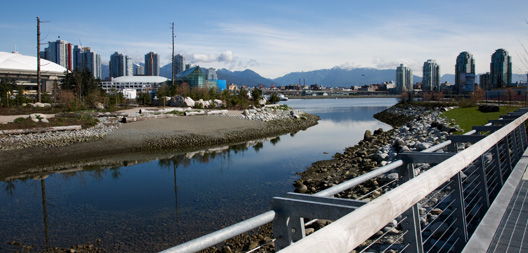Durante Kreuk
Durante Kreuk, an award-winning landscape architecture firm with over 30 years of experience in design and development of private and public realms, took on the challenge of fulfilling the ODP’s requirement for “greening” fifty percent of the rooftops of Olympic Village.
“Stormwater management and green roofs have been standard practice for 30 years,” says co-founder Peter Kreuk. “What’s new is that we are now looking at how buildings and their infrastructure can work in synchronicity with landscape systems. For the Olympic Village, our goal was to recirculate and use rainwater to support landscape irrigation, toilet flushing and rainwater gardens, and we did it.”
Durante Kreuk believes in an integrated team approach to solving design problems; they push boundaries by exploring how to make previously unoccupied, often ugly spaces into places of curiosity, beauty and community building.
Kreuk says, “We believe sustainable development can be incorporated into designs that are highly aesthetic and meet the environmental and social
aspirations of the community.”
Patrick Lucey
Aqua-Tex Scientific Consulting Ltd.
Patrick Lucey’s background spans marine, intertidal and freshwater aquatic ecology, as well as 10 years spent in the construction industry. Originally planning to be a pediatrician, a professor changed his mind. “He said the world will have enough pediatricians in 25 years,” says Lucey. “What it will need is planetary physicians – people who understand how nature structures the world we live in.” Lucey now advocates that every community have a staff “municipal ecologist.” “When we have a question about how the landscape works, there is no one to go to, whose primary role is to understand how the landscape we live in functions, and whether it is healthy or not.”
Lucey’s work has led to several trademarked concepts. The first is “regenerative adaptive design.” “It’s not enough to mitigate damage,” he says. “We need to regenerate natural capital and ecosystem services, and close the loops of energy and water. That’s the design process embodied at SEFC.”
Another concept is “engineered ecology.” “We have to continue our shift from the engineering we’ve done for 2,000 years, past environmental engineering that started in the 1970s, to the newest form of high tech on the planet – engineered ecology.”
Lucey points to the success of the newly rehabilitated shoreline at SEFC, where herring have spawned for the first time in decades. “That’s amazing; herring are very sensitive. They told us, “you guys got it right.”
Gary Romanetz
PEng, Stantec
“I grew up on a farm in rural Manitoba that had its share of man-made drainage issues,” says Garry Romanetz of Stantec, who designed the stormwater management plan for SEFC. “We basically had a river that ran through our farm, and a big wetland area. My dad would frequently give me a shovel and send me out to dig a ditch in order to get the water off the farmland fields. I’ve had a passion for working with stormwater and I’ve focused most of my career on it – I guess you could say I’ve been doing drainage work since I was a kid.”
Romanetz says the Olympic Village project was complex because of the many goals – from flood protection and aesthetic values to implementing new designs and “celebrating water” – that were to be achieved on a site with limited space.
“There were a lot of ideas,” he says, “but my challenge was how to ‘engineer’ them and get approval from the engineering and operations department. A lot of green ideas potentially have a cost premium and then a long-term maintenance component. I think we managed to balance the concerns of engineering and planning and maintenance for years to come.”
Wally Konowalchuk
PEng, City of Vancouver
Over six years with the City of Vancouver, Wally Konowalchuk was involved with other sustainability-oriented projects before SEFC. Still, the complexity of building the Olympic Village has been a challenge, particularly trying to adapt current standards to allow for greener options.
“People developed those standards over time, for good reasons,” he says. “But they become ‘this is what you always have to do.’ People get concerned about who is liable, for instance.
“It’s evident now that to solve our issues, we have to think outside the box, outside of our own little silo, to come to a greater good. If you don’t, you lose a lot of the true functions of engineering – about taking science and applying it to overcome a problem, not just applying science as it was understood 20 years ago.
“Without taking risks, we won’t make improvements. We’ll just keep building the way we build now – which we know doesn’t work. We’ve got global warming and environmental problems, so we all have to scratch our heads and say, ‘How do we change that?’ Once people wrap their minds around that, they really get into it. They say, ‘What can we do, how can we overcome this challenge?’”
Peter Kreuk
“This project was fun, mentally challenging and a great initiative,” says Peter Kreuk, a landscape architect and co-President of Durante Kreuk. Kreuk led the design of building landscapes for Millennium Water.
With 30 years’ experience in the design and construction industry, Kreuk’s knowledge and understanding of municipal requirements and guidelines are paramount in leading projects from the initial design stage through to project completion. Kreuk has worked with Millennium on a number of projects. However, the scale and complexity of this project was new.
“Some of the most interesting parts of the Olympic Village project are the rainwater features. They are great and we are thrilled to be a part of their innovation,” says Kreuk. “The complexity of roof forms also makes it an interesting place. Each garden is a special place. The excitement is how it all fits together.”
